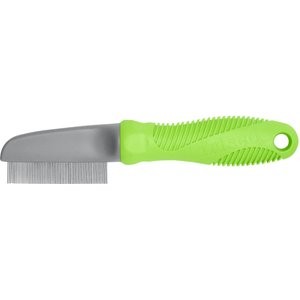Fleas are a common nuisance for pet owners, and if you’re noticing itchy bites, you might be wondering, “Can Humans Get Fleas From Their Pets?” The simple answer is yes, humans can get fleas from their pets. While fleas prefer furry animals like dogs and cats, they are opportunistic and will bite humans if the opportunity arises. This article from pets.edu.vn will delve into how fleas can transfer from pets to humans, what to do if you get flea bites, and most importantly, how to prevent flea infestations in your home and on your beloved pets.
Fleas are tiny, wingless insects that feed on the blood of mammals and birds. They are agile jumpers, which allows them to easily move between hosts. When your pet, be it a dog or cat, picks up fleas, these tiny parasites can indeed jump onto you. However, it’s important to clarify that while fleas will bite humans, they cannot live on humans in the same way they live on pets. Human bodies lack the dense fur that fleas need for hiding, breeding, and laying eggs. So, while you can get bitten by fleas originating from your pet, you won’t become a long-term host.
Identifying Flea Bites on Humans
Flea bites on humans are typically small, red, and intensely itchy bumps. They often appear in clusters or lines, commonly around the ankles, legs, and waist – areas easily accessible to fleas jumping from the floor or pets. You might notice:
- Small, raised bumps: Flea bites are smaller than mosquito bites and usually have a distinct red spot in the center.
- Intense itching: Flea saliva is irritating and causes significant itching.
- Clusters or lines of bites: Fleas often bite multiple times in an area as they explore the skin.
- Location: Bites are most common on ankles, legs, wrists, and arms – areas of exposed skin.
While flea bites are uncomfortable, they are generally not dangerous for humans. However, excessive scratching can lead to secondary skin infections.
Treating Flea Bites on Humans
Fortunately, treating flea bites on humans is usually straightforward. Here’s what you should do:
- Wash the bites: Gently wash the bite area with soap and water. This helps to clean the area and reduce the risk of infection.
- Apply a cold compress: A cold compress or ice pack can help to reduce swelling and alleviate itching.
- Over-the-counter antihistamine cream: Apply an over-the-counter antihistamine cream or lotion to relieve itching. Calamine lotion can also be helpful.
- Avoid scratching: As tempting as it is, try to avoid scratching the bites. Scratching can break the skin and lead to infection.
- Oral antihistamines (if needed): If the itching is severe or widespread, you can take an oral antihistamine to help manage the itchiness.
In most cases, flea bites on humans will heal on their own within a week or two with home care. If you notice signs of infection, such as increased redness, swelling, pain, pus, or fever, consult a doctor.
Addressing the Source: Fleas on Your Pet
If you’re getting flea bites, it’s highly likely your pet is the source of the problem. Treating your pet for fleas is crucial to not only alleviate their discomfort but also to prevent further bites on yourself and other household members. Here’s how to tackle fleas on your dog:
-
Flea Comb: Start by using a flea comb to physically remove fleas and flea dirt (flea feces) from your dog’s coat. Pay close attention to areas around the neck, base of the tail, and belly.
Image alt text: Close-up of a Frisco Single-Row Flea Comb for Cats & Dogs, a tool used to remove fleas and flea dirt from pet fur.
-
Flea Shampoo: Bathe your dog with a flea shampoo formulated to kill adult fleas. Ensure the shampoo is safe for your dog’s age and health condition, especially for puppies.
Image alt text: Bottle of Skout’s Honor Flea & Tick Dog Shampoo, a product designed to eliminate fleas and ticks from dogs during bath time.
-
Flea and Tick Preventatives: The most effective way to manage fleas is through preventative medications. Consult your veterinarian about the best flea preventative for your dog. Options include topical treatments, oral medications, and flea collars. Popular and vet-recommended options include Frontline Plus, Seresto collars, and K9 Advantix II. Ensure you choose the correct dosage based on your dog’s weight.
Image alt text: Single dose packaging of K9 Advantix II Flea & Tick Spot Treatment for small dogs, a monthly topical solution to prevent fleas and ticks.
Image alt text: Seresto Flea & Tick Collar for small dogs, an eight-month flea and tick prevention collar.
Image alt text: Pack of Frontline Plus Flea & Tick Spot Treatment for small dogs, a three-month supply of topical flea and tick prevention.
Eliminating Fleas from Your Home Environment
Treating your pet is only one part of the battle. Fleas can infest your home environment, particularly carpets, rugs, pet bedding, and upholstery. To effectively get rid of fleas and prevent re-infestation:
-
Vacuum Thoroughly: Vacuum all carpets, rugs, floors, upholstered furniture, and crevices, especially where pets spend time. Vacuuming helps to remove fleas, flea eggs, larvae, and pupae. Dispose of the vacuum cleaner bag immediately outside to prevent fleas from escaping back into your home.
Image alt text: Black+Decker Dustbuster AdvancedClean+ Pet Cordless Hand Vacuum, suitable for cleaning pet hair and fleas from hard-to-reach areas.
-
Wash Bedding: Wash all washable bedding, including pet bedding, human bedding, throw rugs, and blankets, in hot water and laundry detergent to kill fleas and their eggs.
-
Flea Sprays for Home: Use an indoor flea spray containing an Insect Growth Regulator (IGR). IGRs disrupt the flea life cycle, preventing larvae from developing into adult fleas. Treat carpets, rugs, pet bedding, upholstery, and cracks and crevices. Products like Vet’s Best Indoor Flea & Tick Home Spray and Wondercide are designed for home use and are pet-friendly when used as directed.
Image alt text: Wondercide Rosemary Home & Pet Flea & Tick Spray, a natural flea and tick control spray safe for home and pet use.
Image alt text: Vet’s Best Indoor Flea & Tick Home Spray, an indoor spray to kill fleas and ticks, shown in a refill bottle.
Yard Treatment for Flea Control
Fleas can also live in your yard, especially in shaded, grassy areas. If your pet spends time outdoors, consider treating your yard, focusing on areas your pet frequents. Use a yard spray containing an IGR, and repeat applications as directed by the product label, typically every 14-21 days for a few months.
Image alt text: Vet’s Best Advanced Strength Flea and Tick Shampoo + Yard & Kennel Spray, a product for both pet bathing and yard flea control.
Persistence is Key
Flea pupae can remain dormant in cocoons for extended periods, sometimes up to nine months, and are resistant to many insecticides. This means that fleas can reappear even after treatment. Consistent flea prevention for your pet and regular home and yard treatments are crucial for long-term flea control. If fleas return, repeat the treatment process for your pet, home, and yard.
Conclusion
Yes, humans can get fleas from their pets, but thankfully, they are not a preferred host and infestations on humans are not possible. Focusing on consistent flea prevention for your pets, along with thorough home and yard flea control measures, is the best way to protect both your furry friends and yourself from these irritating pests. If you’re struggling to manage fleas, consult with your veterinarian for the most effective treatment and prevention plan tailored to your pet and environment.

